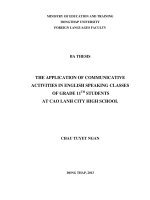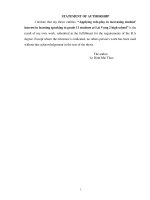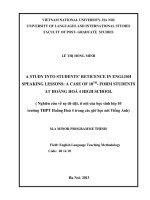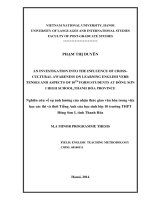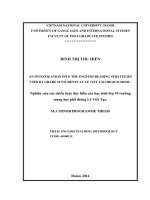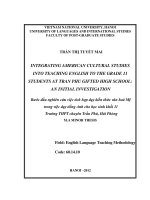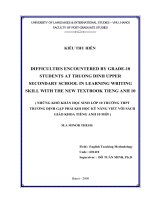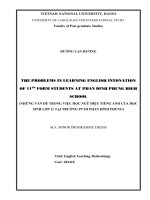Adapting while reading tasks in english 10 to improve reading ability of grade 10 students at yen dinh 1 high school
Bạn đang xem bản rút gọn của tài liệu. Xem và tải ngay bản đầy đủ của tài liệu tại đây (1.5 MB, 53 trang )
VIETNAM NATIONAL UNIVERSITY, HANOI
UNIVERSITY OF LANGUAGES AND INTERNATIONAL STUDIES
FACULTY OF POST-GRADUATE STUDIES
------
HA THI HOAI LAM
Adapting while-reading tasks in English 10 to improve
reading ability of Grade-10 students
at Yen Dinh 1 High School
(Thiế t chỉnh các nhiệm vụ học tập trong khi đọc để nâng cao
khả năng đọc hiểu cho học sinh lớp 10 tại trường THPT Yên Định 1)
M.A. MINOR THESIS
Field: English Teaching Methodology
Code: 60.14.10
Hanoi – 2011
VIETNAM NATIONAL UNIVERSITY, HANOI
UNIVERSITY OF LANGUAGES AND INTERNATIONAL STUDIES
FACULTY OF POST-GRADUATE STUDIES
------
HA THI HOAI LAM
Adapting while-reading tasks in English 10 to improve
reading ability of Grade-10 students
at Yen Dinh 1 High School
(Thiế t chỉnh các nhiệm vụ học tập trong khi đọc để nâng cao
khả năng đọc hiểu cho học sinh lớp 10 tại trường THPT Yên Định 1)
M.A. MINOR THESIS
Field: English Teaching Methodology
Code: 60.14.10
Supervisor: Nguyen Huyen Minh, M.A
Hanoi – 2011
iv
TABLE OF CONTENTS
DECLARATION
i
ACKNOWLEDGEMENTS
ii
ABSTRACT
iii
TABLE OF CONTENTS
iv
LIST OF TABLES AND CHARTS
vii
PART I. INTRODUCTION
1
1. Rationale
1
2. Aims of the study
1
3. Research questions
2
4. Methods of the study
2
5. Scope of the study
2
6. Significance of the study
2
7. Design of the study
3
PART II. DEVELOPMENT
4
CHAPTER 1. LITERATURE REVIEW
4
1.1. Reading and teaching reading skills
4
1.1.1. Definition of reading
4
1.1.2. Types of reading
4
1.1.2.1. Intensive reading
4
1.1.2.2. Extensive reading
5
1.1.3. Characteristics of an effective reader
5
1.1.4. Teaching reading skills
6
1.1.4.1. Approaches to teaching reading
6
1.1.4.2. Common factors in teaching and learning reading
6
1.1.4.3. Stages of a reading lesson
8
1.2. Reading tasks
12
1.2.1. What is a task?
12
1.2.2. Definition of reading tasks
12
1.2.3. Features of reading tasks
13
v
1.2.4. Components of reading tasks
13
1.2.4.1. Goal
13
1.2.4.2. Reading materials
14
1.2.4.3. Arrangement
15
1.2.4.4. Evaluation
15
1.2.5. Types of Reading Tasks
15
CHAPTER 2. METHODOLOGY
16
2.1. Situation analysis
16
2.1.1. The setting of the study
16
2.1.2. Subjects
17
2.1.3. Reading materials
17
2.2. Participants
19
2.3. Data collection instruments
19
2.3.1. Survey questionnaires
19
2.3.1.1. Questionnaire for students
19
2.3.1.2. Questionnaire for teachers
20
2.3.2. Class observation
20
CHAPTER 3. DATA ANALYSIS AND DISCUSSION
21
3.1. Data analysis and discussion of the students’ survey questionnaire
21
3.1.1. Students’ attitude towards reading skill
21
3.1.2. Students’ attitude towards while-reading tasks
22
3.1.3. The frequency of using while-reading techniques designed by teachers
24
3.1.4. Students’ difficulties when learning reading
27
3.1.5. Students’ effort for improving reading ability
28
3.1.6. Students’ preferences for participation in while-reading tasks
29
3.1.7. Students’ expectation towards teachers’ reading techniques
29
3.2. Data analysis and discussion of the teachers’ survey questionnaire
30
3.2.1. Teachers’ attitude towards reading skill
30
3.2.2. Teachers’ attitude towards while-reading tasks
30
3.2.3. The frequency of using while-reading techniques
31
3.2.4. Teachers’ difficulties when teaching reading
33
vi
3.2.5. Teachers’ effort for improving reading ability
34
3.3. Data analysis and discussion of the observation
35
CHAPTER
4.
APPROACHES
MAJOR
FOR
FINDINGS
ADAPTING
AND
SOME
WHILE-READING
SUGGESTED
TASKS
TO
IMPROVE READING ABILITY FOR GRADE 10 STUDENTS
37
4.1. Major findings
37
4.1.1. Research question 1: What are the teachers’ and students’ attitudes towards
while-reading tasks?
37
4.1.2. Research question 2: What have teachers and students done to improve
reading ability?
37
4.2. Some suggested approaches for adapting while-reading tasks to improve
reading ability for Grade-10 students
38
4.2.1. Raising the students’ awareness of the importance of reading in learning
grammar and vocabulary
38
4.2.2. Training students into strategic readers
39
4.2.3. Adapting the textbook
39
PART III. CONCLUSION
40
1. Conclusions
40
2. Limitations and suggestions for further study
40
REFERENCES
41
APPENDICES
I
APPENDIX 1
I
APPENDIX 2
IV
APPENDIX 3
VI
vii
LIST OF TABLES AND CHARTS
1. List of tables
Table 1. Students’ attitude towards while-reading exercises
Table 2. Problems students face when learning reading
Table 3. Students’ expectation towards teachers’ reading techniques
Table 4. Teachers’ attitude towards while-reading tasks
Table 5. The frequency of using while-reading exercises or activities
Table 6. Problems teachers face when teaching reading
Table 7. Teachers’ activities to help students overcome difficulties
2. List of charts
Chart 1. Students’ attitude towards the importance of reading skill
Chart 2. Students’ attitude towards the benefit of reading
Chart 3. Students’ attitude towards the importance of while-reading tasks
Chart 4. Students’ opinions on while-reading tasks
Chart 5. Students’ reluctance of doing while-reading tasks
Chart 6. The frequency of using while-reading exercises or activities designed by teachers
Chart 7. The frequency of limiting the time of doing exercises
Chart 8. Students’ ways of overcoming difficulties
Chart 9. Students’ preferences for participation in while-reading tasks
Chart 10. The frequency of designing while-reading exercises or activities
Chart 11. Time allowance in doing reading exercises
1
PART I. INTRODUCTION
1. Rationale
Nowadays, the acquisition of English language is a priority for millions of people in
Vietnam. At high schools, English has become a compulsory subject in the state
examination and it is one of three subjects for some universities‟ entrance exam. Besides
the aim of passing their exams and getting some further studies for their future life, all
students have a desire to integrate into the culture, the civilization, the country, and the
people of Great Britain and of other English speaking countries.
Having taught English to high school students for over 10 years, the writer of this study
realizes that reading is not only an important means to gain knowledge but also a means by
which further study takes place because the reading skill offers learners a wide range of
interesting information as well as a variety of language expressions and structures, which
are of great usefulness for developing other skills.
However, students often have some difficulties, especially in the while-reading stage of the
three-staged reading lesson: pre-reading, while-reading, and post-reading. Actually, whilereading tasks occupy most of the time in a reading lesson. Completing while-reading tasks
means students can understand the writer‟s purpose and clarify the text‟s content in detail.
Students may lack of vocabulary, grammar, background knowledge or strategies of doing
exercises. To help students overcome these difficulties, teachers have applied many
teaching approaches. Unfortunately, the results are not very satisfactory for various reasons.
This fact has encouraged the author to investigate into teachers‟ and students‟ opinions on
while-reading tasks, what they have done with while-reading tasks to improve reading
ability and to give some suggested approaches for adapting while-reading tasks. The
researcher hopes that the study “Adapting while-reading tasks in English 10 to improve
reading ability of Grade-10 students at Yen Dinh 1 High School” will be helpful for the
author and other reading teachers in some way to find appropriate approaches to help their
students improve reading ability.
2. Aims of the study
The purposes of the study are to investigate while-reading tasks employed by the teachers
at Yen Dinh 1 High School and to give some suggestions for adapting while-reading tasks
to improve reading ability of Grade-10 students at Yen Dinh 1 High School. The specific
aims of the research are as follows:
2
To investigate teachers‟ and students‟ attitudes towards the while-reading tasks in
English 10 textbook.
To find out how teachers help students with the while-reading tasks.
To explore the need to adapt the while-reading tasks to reduce the students‟
difficulties.
3. Research questions
1. What are the teachers‟ and students‟ attitudes towards while-reading tasks?
2. To what extent do teachers adapt the while-reading tasks to help the students
comprehend the text better?
4. Methods of the study
The study was carried out on the basis of material collection, survey questionnaire and
class observation.
In the first place, for the theoretical basis, a lot of reference materials on the reading skill,
reading tasks have been gathered, analyzed and synthesized thoroughly with the due
consideration for the teachers‟ and students‟ teaching and learning situations.
Secondly, for the practical basis, questionnaires and on-the-spot observations are carried
out with the teachers and students to gather the most reliable data for the thesis.
5. Scope of the study
Studying tasks and their effects on the second language have been paid attention by many
researchers recently. This study only investigates adapting while-reading tasks in English
10 to improve reading ability of Grade-10 students at Yen Dinh 1 High School. Because of
the limited time and within an M.A. minor thesis, the researcher tends to identify teachers‟
and students‟ attitudes towards while-reading tasks, examine approaches and activities
used by teachers and students‟ preferences and demands; then suggests some approaches
for teachers to adapt while-reading tasks to improve students‟ reading ability.
6. Significance of the study
The study has been carried out to search for a better and more effective ways of adapting
while-reading tasks. Its findings hopefully would help Grade-10 students find out suitable
ways to improve their reading ability. Regarding teachers, the study would arouse their
flexibility in using methods to develop their students‟ reading ability.
3
7. Design of the study
The thesis is divided into three parts: the introduction, the development and the conclusion.
The introduction deals with the rationale, aims, scope, methods, significance and design of
the study.
The development consists of four chapters. Chapter 1, Literature Review, is intended to
give some theoretical background related to reading, teaching reading skills and reading
tasks. Chapter 2 presents the methodology used in the study including situation analysis,
participants and data collection instruments. Chapter 3 shows an analysis and discussion on
the data collected from the questionnaires and on-the-spot observations. The last chapter
offers some major findings, suggested approaches for adapting while-reading tasks.
The conclusion is a review of the study, limitations of the study and suggestions for further
research.
4
PART II. DEVELOPMENT
CHAPTER 1. LITERATURE REVIEW
1.1. Reading and teaching reading skills
1.1.1. Definitions of reading
Reading is a huge topic, potentially beset with myriad difficulties not easily addressed in a
book of this length (Dean, 2000:2). Goodman (1971:135) defines reading is “a
psycholinguistic process by which the reader, a language user, reconstructs, as best as he
can, a message which has been encoded by a writer as a graphic display”, and the act of
reconstruction is viewed as “a cyclical process of sampling, predicting, testing and
confirming.”
Ur‟s preliminary definition is “reading means reading and understanding” (1996:138).
Harmer (1989:153) defined “reading is an exercise dominated by the eyes and the brain.
The eyes receive messages and the brain then has to work out the significance of these
messages.”
Moreover, Rubin and Thompson (1994:91) also defined reading as: “an active informationseeking process in which readers relate information in the text to what they already know”.
From this point of view, the readers‟ knowledge of the language and knowledge of the
world is of importance to their reading success.
To sum up, what all the linguists had in common is that reading involves a variety of skills
and reading usually means comprehending written language so when understanding breaks
down, reading actually has not occurred.
1.1.2. Types of reading
Reading is very important to our life. However, the reasons for reading differ from one
person to another. As a result, the ways we read are also different. In other words, the
purposes of reading determine the ways or the styles of reading. Nuttall (2000:38) indicates
two main types of reading, namely, intensive and extensive reading. For him, these are not
just two contrasting ways of reading but an infinitive variety of interrelated and
overlapping strategies. Actually, intensive and extensive readings are complementary and
both are necessary.
1.1.2.1. Intensive reading
Intensive reading “involves approaching the text under the guidance of a teacher or a task
which forces the students to focus on the text" (Nuttall, 2000:38). In the view of Brown
5
(1990:297) intensive reading “is usually a classroom-oriented activity in which students
focus on the linguistic or semantic details of a passage”.
Grellet (1981:4) states that “Intensive reading means reading short texts to extract specific
information. This is an accuracy activity involving reading for detailed”. The objective of
intensive reading is to achieve a full understanding of the text not only of what it means
but also of how the meaning is produced. Through intensive reading, the reader must arrive
at a profound and detailed understanding of logical arguments, the rhetorical arrangement,
the pattern of the text, the attitude and purposes of the writer and his linguistic means to
achieve his purposes. In other words, intensive reading might be called reading for
accuracy, which is essential to the students‟ comprehension.
1.1.2.2. Extensive reading
Extensive reading is used to obtain a general understanding of a subject and includes
reading longer texts for pleasure, as well as business books. Use extensive reading skills to
improve our general knowledge of business procedures. Grellet (1981:4) points out
“Extensive reading means reading longer texts, usually for one‟s pleasure. This is a fluency
activity, mainly involving global understanding”. What is more, Nuttall (2000:127) argues
that “getting students to read extensively is the easiest and most effective way of
improving their reading skills”.
Extensive reading is considered to be useful for students‟ self-learning. Their reading habit
and passion for reading are also formed through extensive reading. Students can choose the
topics they like and read for their own purpose for pleasure or entertainment. However, it
is more effective if students‟ extensive reading is followed an instructional program with
the help of the reading teacher.
In short, reading is necessary to every learner and undeniably an important skill in
comparison with others. In addition, it is notable that intensive and extensive reading
should not be seen as in being opposition but need to be paid equal attention for the sake of
the students. For second or foreign language learners, both intensive and extensive
readings are of great importance as they act as a means to gain knowledge.
1.1.3. Characteristics of an effective reader
Being an effective reader is a great desire for everyone, especially for second and
foreign language readers. However, it is unnecessary to be a genius or have an
exceptionally high IQ to read well. According to Wassman and Rinsky (1993:5), an
6
effective reader needs “an understanding of the reading process and an
understanding of how to go about reading different types of printed information”.
In this way, a second or foreign language learner can practice techniques that will
help to succeed in becoming an effective reader. Besides, they also point out two
necessary ingredients for an effective reader, i.e. the willingness to change reading
habits that limit the learner‟s reading ability and the willingness to practice.
1.1.4. Teaching reading skills
1.1.4.1. Approaches to teaching reading
Reading is one of the most important ways for people to get information, to take pleasure,
and to obtain knowledge. For many students, reading is the most important of the four
skills (listening, speaking, reading and writing) to get a high mark in the examinations or to
get a better job. In English reading teaching, there have been some traditional language
learning techniques that have been used for many years, such as Grammar-Translation
Method, Question-and-answer Model and PPP Model. Traditional approaches have a
number of advantages. However, the focus of traditional teaching is on language form and
the class is teacher-centered. Students depend too much on the teacher and lack a sense of
responsibility for their own learning.
Nowadays, many other approaches are being applied in order to make the reading class
more effective such as task-based approach, content approach, … According to Willis
(1996:24-25) states what task-based approach pursues is to provide abundant input for
students and make sure learners set clearly defined goals, which makes the teaching more
communicative and provides aims for classroom activities.
1.1.4.2. Common factors in teaching and learning reading
1.1.4.2.1. Reading texts
Texts play an important role in teaching and learning reading because they are a means to
introduce new lexical, phonetic as well as grammatical items of the target language and
they are also means to help students to enrich their background knowledge. Thus, the
teacher needs to take the following points into consideration (Grellet, 1981: 20) when
choosing appropriate authentic texts to suit with different reading activities:
-
The language of the text
-
The content of the text
-
Vocabulary and grammatical structures
7
-
Types of reading activities
To the teacher at the secondary school, the textbook will be the main source of reading
materials for his students in the reading class. He sometimes can use texts outside the
textbook which are both suitable for the students‟ level and interesting enough to attract their
attention and encourage them to read.
1.1.4.2.2. Teacher’s roles
It is natural that in a reading lesson, the students must work actively and individually. It does
not mean that the teacher has nothing to do. Concerning the roles of the teacher in teaching
reading, Harmer (2001:213) states that the teacher needs to create interest in the topic and
task. He also needs to work as an observer, feedback organizer and prompter.
An observer: While students are reading, the teacher can observe their progress
since it will give him valuable information about how well his students are doing
individually or collectively, and will tell him whether to give them extra time, or move to
organize feedback more quickly than he has anticipated.
A feedback organizer: When the students have completed the given tasks, the
teacher can lead a feedback session to check if they have completed the task successfully
or not. He may start by having his students compare their answer in pairs or in groups and
then ask for their answers. When asking students to give answers, it is effective to ask them
where in the text they found the information. This will help him recognize his students‟
problems if their answers are inappropriate.
A prompter: When students are reading the text, it is also necessary to draw
their attention to the language features in that text. He may direct his students to certain
features of the text construction, clarify ambiguities and make them aware of issues of the
text structure which they have not come across previously.
Referring to this issue, Moore (1992:5) adds: “The teacher is an environmental engineer
who organizes the classroom space to fit their goal and to maximize learning. The way the
physical space of the classroom is organized can either help or hinder learning”
In this case, it is plausible to create an environment of a communicative classroom where
meaningful and useful reading activities are carried out, so that the students can best acquire
reading skills and practice other language skills.
8
In general, the teacher must be aware of what they need to do in a reading lesson. Playing
their roles well will certainly help the teacher lead successful reading lessons. It will help
students understand the text efficiently, and at the same time improve considerably their
reading skills.
1.1.4.2.3. Students’ roles
Nuttall (2000:33) mentions several main roles for the students in a reading lesson. They are
as follows:
- Taking an active part in learning: this is the first and foremost responsibility of the learner.
They have to be active and take charge of what they do.
- Monitoring comprehension: Students need to understand how texts work and what they
do when they read. And they must be able to monitor their own comprehension, for
instance, be able to recognize that they do not understand a text, find out why and adopt a
strategy that will improve the problem.
- Learning text talk: It is clear that a good reader carries on a dialogue with the text.
Consequently, the students have to learn how to do this. An effective way to promote this
skill is to talk about texts in class.
- Taking risks: The students have to take the risk of making mistakes because a mistake is
an opportunity to learn.
- Learning not to cheat oneself: learning to read is learning to give the students enormous
advantage in life. It may lead to better jobs, to personal development, interest and
enjoyment. Students who do not want to learn to read can easily cheat but they are only
cheating themselves. Nobody else will suffer but they are wasting their opportunities.
In summary, students are the key factor to decide the success of a reading lesson. Teacher
and students are interrelated to each other during the process of teaching and learning
reading skills.
1.1.4.3. Stages of a reading lesson
A reading lesson can be divided into three stages which are pre-reading stage, whilereading stage and post-reading stage. Each of these stages carries its own features and
purposes and requires different techniques and strategies (William, 1984:37)
1.1.4.3.1. Pre-reading stage
In this early stage, teachers are expected to motivate students to read, especially by
activating or building students‟ background knowledge of the subject and familiarizing
9
them with some of the language needed in coping with the text. According to Williams
(1984:37), the purposes of the pre-reading stage are:
-
To introduce and arouse interest in the topic.
-
To motivate learners by giving a reason for reading.
-
To provide some language preparation for the text.
Normally, pre-reading phase often lasts from two to ten minutes depending on each lesson.
Before delivering activities for this stage, the teacher needs to take the objectives of the
lesson, the situation of teaching and learning, the students‟ needs into account.
1.1.4.3.2. While-reading stage
While- reading stage is the main part of a reading lesson. Without this stage, the students
will lose the chance to deal with the text to understand the writer‟s purpose and clarify the
text‟s content in detail. Williams (1984:38) points out the aims of the while- reading stage:
- To help to understand of the writer‟s purpose.
- To help to understand of the text structure.
- To clarify the text.
He also gives the teacher some questions to ask himself in order to deal with the above
mentioned aims:
1. What is the function of this text?
2. How is the text organized or developed? (e.g.: a narrative, an explanation with
various examples, an argument and counter argument)
3. What content or information is extracted from the text?
4. What may the reader anger or deduce from the text?
5. What language may be learned from the text?
6. What reading styles may be practiced?
It is clear that, question (1) deals with the aims of understanding, the writer‟s purpose, and
question (2) helps to recognize the text structure and the rest help to clarify the text content.
The answers to these questions will be a guide for the teacher in this stage. Depending on
their answers, the teacher will choose suitable activities for students which focus them on
exploiting the meaning of the text, and develop their reading skills.
Concerning the while- reading stage‟s activities, in his research, William (1984:39) has a
more generating idea: “While- reading work should begin with a general or global
10
understanding of the text, and then move to smaller unit such as paragraphs, sentences and
words”
It is clear that all the activities suggested by Sheils can be included in the two categories
mentioned by Williams, i.e. reading for general understanding first, and the reading for
specific information. In the while-reading stage, to direct students to the general
understanding of the text, the teacher may ask them to guess the title, to match the heading
etc. He also may ask students to find out the specific information in the text by answering
the questions, to use the information in the text for completing tables or diagrams.
Furthermore, the students can focus only on individual language item by deducing the
meaning of the new lexical items, etc.
Mathews, Spratt and Dangerfield (1999:67) suggest a number of reading skills in
accordance with activities.
Skills
Activities
1. Jumbled sentences or paragraphs.
2. T circles the references devices in a text and SS work out
what they refer to.
Understanding
relation
the 3. T gives students a passage in which the logical connectors
between are blanked out. Students have to read the passage and work
sentences and clauses
out what the connector must be.
4. Prediction exercises: Students only read the first line and
then predict the next.
Recognizing the effect of
style
Recognizing
organization of a text
Making inferences
1. Multiple choice or True/ False questions
2. Discussion on the style of the text.
3. Parallel passage in different style.
the 1. Jumbled paragraphs
2. Discussing the function of particular paragraphs.
True/ false or discussion questions on possible interpretation of
the text
Extensive reading
Students read on a self- access basis from a class reading bank.
Skimming for the gist
1. The text is used simply as spring board for discussion on a
11
particular topic.
2. Students read through a passage and then suggest a title for
this.
3. Students match different titles to series of short texts within a
given time limit.
Scanning
for
information
specific
1. Underlining or circling the required information in a given time
limit.
2. Pre- questions focusing on specific information
1. Information transfer activities.
Reading for detail
2. Note- taking on the order of events or emotion in a text.
3. True/ false questions.
4. Jigsaw reading
Indeed, there are various activities the teacher can choose for his students in this stage. It is,
however, essential to be flexible in this task. The selection of any of them depends on the
nature of the reading text and the level of the students. Besides selecting suitable activities,
during the while- reading stage, the teacher should bear in mind his roles of an organizer,
observer, assessor and prompter as mentioned in the part, teacher‟s roles.
1.1.4.3.3. Post-reading stage
The post-reading stage is the final but not the least important stage of a reading lesson
because it is time for students to apply what they have got from the text into real life
communication. In Williams‟ opinions (1984: 39), the post-reading stage aims at:
1. To consolidate or reflect upon what has been read.
2. To relate the text to the learners‟ own knowledge interest or views.
In summary, each of the reading stage carries its own aims and activities. It is very
effective if these three stages are combined flexibly and appropriately for an efficient
reading lesson. In the while- reading stage, it is necessary to help the students improve and
develop sub-reading skills such as skimming, scanning, or reading for details. If the
students can acquire these skills, it is easier for them to understand efficiently the
significance of the text. To acquire these skills, students may be instructed to take part in
various tasks or activities according to each skill. There are numerous tasks or activities in
this stage. The teacher should be flexible in choosing them for their reading lessons. In the
12
process of reading, asking students to work in pairs or groups is also advisable. This may
enable students to feel more pleasant in reading, encourage them to work harder to
improve and develop effective reading skills.
1.2. Reading tasks
1.2.1. What is a task?
In general education, and in other fields such as psychology, there are many different
definitions of tasks. There is also quite a variety from within the field of second language
teaching.
Long‟s (1995) definition: A task is a piece of work undertaken for oneself or for others,
freely or for some reward. Thus, examples of tasks include painting a fence, dressing a
child, filling out a form, buying a pair of shoes, making an airline reservation, borrowing a
library book, taking a driving test, typing a letter, weighing a patient, sorting letters, taking
a hotel reservation, writing a check, finding a street destination, and help someone across a
road. In other words, by task is meant the hundred and one things people do in everyday
life, at work, at play, and in between. Tasks are the things people will tell you they do if
you ask them and they are not applied linguists.
Crookes (1993) states that a task is “a piece of work or an activity, usually with a specified
objective, undertaken as part of an educational course, at work, or used to elicit data for
research.”
Nunan (1989:10) points out that a communicative task is a piece of classroom work which
involves learners in comprehending, manipulating, producing, or interacting in the target
language while their attention is principally focused on meaning rather than form. The task
should also have a sense of completeness, being able to stand alone as a communicative act
in its own right.
Although these researchers emphasize the different aspects of the task, the definitions we
have looked at share something in common: they all imply that tasks involve realistic
language use in which learners focus their attention on meaning rather than linguistic
structures and that learning tasks help learners acquire the ability to perform certain
communicative functions through a new medium.
1.2.2. Definition of reading tasks
In the above part, we have made a list of definitions of task. Though these definitions
emphasize different aspects of tasks, they have something in common. According to these
13
definitions, the writer gives a definition to a reading task like this: A reading task is a piece
of work based on reading materials and reading comprehension. Students do different
kinds of activities by using what they are learning and their schemata to achieve a certain
reading purpose. By doing so, students understand the text, learn and use the new
expressions and try to improve their comprehensive ability to use English in real life.
1.2.3. Features of Reading Tasks
Skehan made a summary of the general features of a task in his book „A cognitive
Approach To Language Learning’. He thought there are five key characteristics of a task
(1998:95)
1. Meaning is primary
2. There is a communicative problem to be solved
3. There is some sort of relationship to comparable real-world activities
4. Task completion has some priority
5. The assessment of the task is in terms of outcomes
Similarly we may find that reading tasks have the following characteristics:
1. It usually aims at a reading purpose that may happen both in their study and
everyday life.
2. The input is mainly in the form of printed or written words.
3. Reading comprehension is the basis of a reading task.
4. Task completion comes first. The teacher has to allow students to try every
means to finish the task.
5. The quality of the outcome of a reading task is the key factor when we evaluate
students' performance during the process of the task completion.
1.2.4. Components of Reading Tasks
Nunan (1989:48) suggests that tasks will have six components. They are goals, input,
activities, teacher‟s role, students‟ role and settings. In this study, a reading task consists of
goals, reading materials, arrangement and evaluation. The writer tries to illustrate the
components of a reading task concretely.
1.2.4.1. Goal
On the one hand, the beginning of task design should be the goals that are set out in the
syllabus or curriculum guidelines. On the other hand, we also need to take account of the
reading objectives in real everyday life. As Nunan (2000:48) said, Goals provide a point of
14
contact between the tasks and the broader curriculum. A reading program can be designed
to provide learners with skills to carry out the hundred and one reading tasks that occur in
daily life; from looking up a program in the T.V. guide, to reading the sporting page of the
afternoon newspaper. On the other hand, it might be designed to develop the specialized
reading skills needed for studying successfully in a second language. Given the importance
throughout the world of English as a medium of instruction at the tertiary level, it‟s not
surprising that a great deal has been written about these second, specialized reading goals.
The problem is what the goals of a reading task are? Then it‟s necessary for us to discuss
why people who learn English as a second language and read English materials in their
daily life. Generally speaking, there are three kinds of purposes:
Reading for information: Most people read in order to get some information they
need in their every life. For example, when people want to go abroad, they look for
the information and read some materials about the country they will go. However, a
lot of people read news in English to know what happening around the world. In
English reading classes, students often try to get useful information to do reading
tasks.
Reading for study: Both students and some adults also read for their study. Study
here has meanings. As for students study means reading to learn a foreign language
as well as to improve their reading skills and strategies. However some adults read
to help research. Most scientists have to read books written in English to help them
know more about what they are studying.
Reading for fun: Why do many people love reading? The major reason is reading
bring happiness. We read jokes, stories, novels, poems, or letters from friends etc.
to enjoy ourselves in our spare time.
1.2.4.2. Reading materials
The input of a reading task is usually printed or written in English. In real classes, we often
call it reading materials. The problem is where we can get the suitable reading materials.
Of course, the textbook is a main resource. However, in current society, we get information
we need easily in many different ways. For example, we may get it from the Internet, a
library, magazines, newspapers, popular songs, and students‟ homework and so on. A good
and convenient way is to make the best use of newspapers and the exercises.
15
1.2.4.3. Arrangement
After making the goals and choosing the reading materials, it is the time to arrange the
class. This is a major part in a reading task. In this part, it includes activities, forms of how
to complete tasks, settings, teaching procedures, teacher‟s role and students‟ role.
1.2.4.4. Evaluation
Why do we need evaluation? Every time when students finish a task, it‟s necessary for
both teachers and students to reflect and evaluate how they perform in a task completion,
what they have learned in this class and how much they have mastered. On the other hand,
it‟s a good chance for us to learn from failure. We try to find the problems we have had in
order to accumulate experiences about how to do the tasks and how to use English better.
In this way, we will do better next time.
1.2.5. Types of Reading Tasks
A reading task is a piece of meaning-focused work involving learners in comprehending,
producing and interacting in the target language, and that tasks are categorized according
to the goals, input reading materials, activities, arrangement and evaluation.
In fact, tasks have different types according to different criteria. For example: According to
the forms of task completion, there are tasks in class, in groups or solo tasks. There are also
opened tasks and closed tasks; According to the places where the students finish the tasks,
we have two types of tasks, in-class tasks and after-class tasks; According to the time that
we need to finish a reading task, there are immediate tasks, short-term tasks and long-term
tasks; According to the ways to get and transfer information, tasks are usually classified by
English educators into three kinds: information gap activities, reasoning gap activities and
opinion gap activities (David, 2004:18).
16
CHAPTER 2. METHODOLOGY
2.1 Situation analysis
2.1.1. The setting of the study
The study was conducted at Yen Dinh 1 High School, a rural school of Thanh Hoa
province. The school has 32 classes with 80 teachers of different subjects. As other high
schools, English is taught here as a compulsory subject. There are now 10 teachers of
English and over 1500 students ranged from Grade 10 to Grade 12. Most of the students
come from villages and a town in the district.
Although English has been taught as a compulsory subject at Yen Dinh 1 High School
since 1995, the teaching of English, especially teaching English reading for Grade 10
students has met some difficulties. First, not all students pay much attention to English.
About one – tenths of the tenth grade students wish to take university entrance exam in
English, so only they are really interested in learning. Second, teachers have to teach in the
large size classes. There are at least 45 students for each class. Therefore, teaching English
reading is very difficult for teachers. Teachers will face with some problems in monitoring
work, supporting, giving feedback and paying attention to all students during class time.
The third is most of the students have poor vocabulary and limited background knowledge.
They feel nervous and pressured when learning reading parts. As a result, they find it
difficult to deal with tasks following each reading text. The last is the lack of materials.
Materials for reference and self-study are not available. Some facilities needed for teaching
and learning such as computers, projectors … are not enough. There is a library for
teachers. However, there are not many books for reference as well as English newspapers
or magazines. There are no language labs and library for students, too.
According to the current syllabus, there are 3 periods (135 minutes) of English every week.
Yet, it is not enough for the students to practice and develop their skills as well as to enrich
their background knowledge, vocabulary and structure capacity. What‟s more, students
hardly read books or printed issues in English outside class. As a result, these may affect
students‟ reading ability in English. So, it is advisable for the teachers to employ various
approaches to arouse students‟ interest in learning English reading. They, then, may
improve their reading skill and other language skills.
17
2.1.2. Subjects
The study was carried out with the participation of 450 grade 10 students and from ten
teachers of English at Yen Dinh 1 high school.
Grade-10 students
Grade-10 students, both male and female, coming from villages and a town in the district,
had the same backgrounds. They have been learning English for over 4 years, 4 years at
secondary school and one semester at Yen Dinh 1 high school.
The students under the investigation have just finished the first term of grade-10 school
year. Lots of them come from comparatively poor families so their learning condition is
low. After classes, they often help their parents with farming and housework and they have
little time for extra-learning and doing homework. Reference books, newspapers and
printed issues in English are not enough. Moreover, some parents do not pay much
attention on their children‟s learning. They always think that English is not a subject for
rural students to study well. In addition, their learning environment is not good. In English
lessons, English is used much by teachers and good students. The others are afraid of using
or reluctant to use because they fear to make mistakes, to lose face or to get bad marks.
They also have no effort and aim to learn. Outside class, English seems never to be used.
As a result, their English level is very low, especially their reading ability.
Teachers
In Yen Dinh 1 high school, there are totally 10 teachers of English, including the
researcher, aged from 27 to 56. Half of them graduated from Hanoi Foreign Languages
Teachers‟ Training College. The rest graduated from Vinh University. The number of
female teachers formed the majority (8 female teachers and 2 male teachers). All of them
are enthusiastic with their career and had at least 4 years experienced in teaching English.
However, since graduating from their respective universities, few of them have taken
refresher courses to improve their English and their teaching methods. These teachers were
trained under the strong influence of the Grammar-Translation method, the emphasis of
which is on the learning of the rules of the language, not on the acquisition of language
skills. This is obviously manifested in their teaching methods.
2.1.3. Reading materials
The main reading material for Grade-10 students is a new set of textbooks. It is designed
following communicative approach. There are five parts in each unit: reading, speaking,
18
listening, writing and language focus in which a variety of exercises and tasks were
compiled for practice. Also, there exist test yourself units of which objectives are to
examine how well the students have achieved in the previous units. The content of the new
textbook is arranged according to themes. Each unit mentions one theme relating to
everyday life, which is very useful and practical to students‟ needs. Those themes will be
exploited and practiced from different skills that are allocated in different periods of fortyfive minutes. Actually, the new textbook is designed with much practical objectives. It
develops language skills comprehensively in the target language, improves communicative
competence of students, and helps students be aware of the learning process, in which
linguistic knowledge is the means of learning, not the ultimate target of language mastery.
Furthermore, it provides students with the fundamental but systematic knowledge of
English at a suitable level and enriches students‟ understanding of their own culture and
other cultures of English speaking countries.
For reading skill, there is always a passage whose topic relates to other three skills. It is
designed with three steps, they are pre-reading, while-reading and post-reading. Prereading often gives questions with clear and beautiful pictures to lead in the topic of the
text. While-reading asks students to scan for specific information and skim for general
ideas. Post-reading also provides useful activities for students and it helps students wrap
things they have learnt form the passage. In general, these are more interesting than the old
textbook and they are completely suitable for the changing of teaching and learning
methods.
Seemingly, various topics in the reading texts are beneficial for reading comprehension
development. However, the reading texts are sometimes challenges for students because
some passages have got new structures, and some topics are unfamiliar with students in the
rural area, such as: Unit 5 is about Computers, Unit 15 is about cities. In fact, many
students in the rural area do not know what a computer is, how many parts there are in a
computer, what New York are famous for, what places in New York the visitors are
attracted to, etc... Therefore, it is not easy for English teachers to explain. Moreover, some
units consist of too many new words and new structures.
19
2.2. Participants
The participants for the survey questionnaires were 135 students selected at random from
class 10A1 to class 10A5 and 9 teachers of English. These students have learnt the new
syllabus since they were in grade 6. When participating in this study, they were in the
second term of the school year. In researcher‟s observation, their English proficiency and
level of motivation were the same.
Nine teachers who have been teaching English at Yen Dinh 1 High School at least for 4
years were invited to join the research. All of the teachers under the investigation have ever
taught grade 10, and some of them were teaching in the academic school year 2010-2011
when the study was carried out. The results from these teachers will give an objective view
on how to improve students‟ reading ability.
All participants took part in the survey by responding to the two kinds of questionnaires,
one for students and one for teachers.
2.3. Data collection instruments
The main instrument used to gather information for the study is questionnaires, one for
students and one for teachers. Added to that, class observation was also employed to
supplement the above instrument.
2.3.1. Survey questionnaires
Two sets of survey questionnaires were completed with the assistance of 135 grade-10
students and 9 teachers of English. The questionnaires were designed in both closed and
opened-ended questions. According to Bill Gillham, using questionnaires has some
advantages: low cost in time and money; easy to get information from a lot of people;
respondents can complete the questionnaires when it suits them, analysis of answers to
closed questions is straightforward; less pressure for an immediate response, respondents‟
anonymity; lack of interviewer bias, standardization of questions (but true of structured
interviews); can provide suggestive data for testing a hypothesis.
2.3.1.1. Questionnaire for students
The questionnaire was designed with three parts with 12 questions. Part one was to explore
the students‟ attitudes towards while-reading tasks. Part two aimed at collecting
information about students‟ effort and teachers‟ applying activities in teaching and learning
while-reading tasks. The final part of the questionnaire was made to find out the students‟
